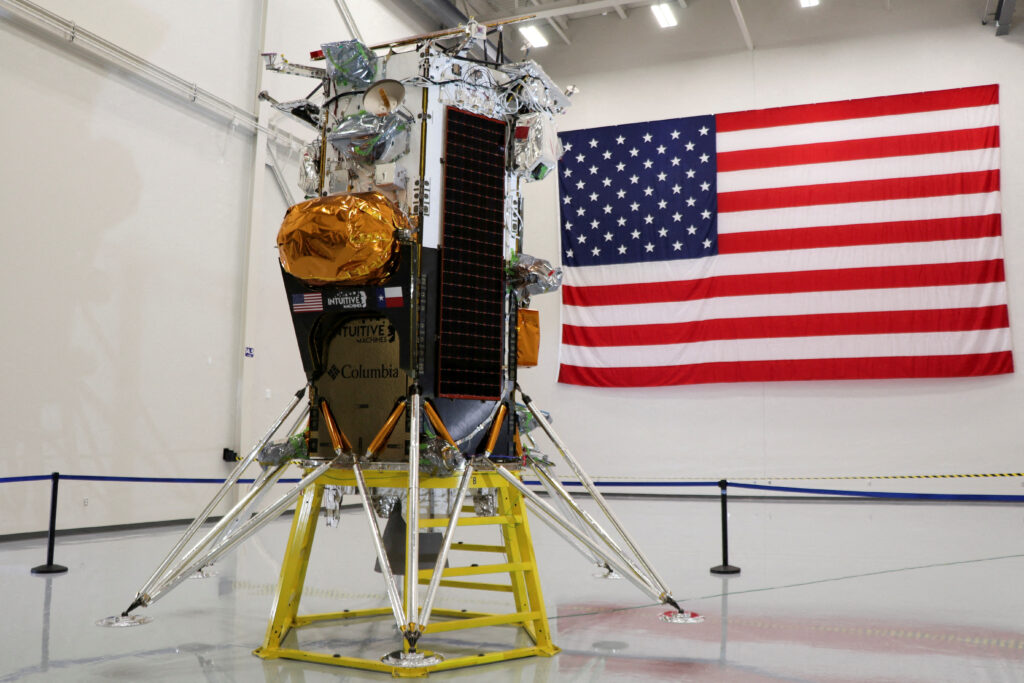Moon landing try in half a century through US private robot spacecraft

The Nova-C lunar lander designed by aerospace company Intuitive Machines is displayed at the company’s headquarters in Houston, Texas, U.S., October 3, 2023. REUTERS/Evan Garcia/File Photo
A spacecraft built and flown by Houston-based company Intuitive Machines began its final descent from lunar orbit on Thursday to attempt the first U.S. moon landing in more than half a century and the first ever conducted entirely by the private sector.
The six-legged robot lander, dubbed Odysseus, was headed toward a touchdown planned for 6:24 p.m. EST (2324 GMT), even as engineers at mission control were working to resolve a last-minute navigation glitch that surfaced on the spacecraft, the company and NASA commentators said in a joint webcast.
READ: NASA’s final tally shows spacecraft returned double the amount of asteroid rubble
Mission controllers were attempting a work-around to a malfunction of the lander’s laser-guided range finders that are necessary to determine the spacecraft’s altitude and horizontal velocity, the commentators said.
As part of its final approach, the spacecraft was expected to execute a “pitch-over” maneuver to place it into a vertical position over the lunar surface as it heads for landing.
The vehicle, targeting a crater named Malapert A near the moon’s south pole, was carrying a suite of scientific instruments and technology demonstrations for NASA and several commercial customers designed to operate for seven days on solar energy before the sun sets over the polar landing site.
The NASA payload will focus on collecting data on space weather interactions with the moon’s surface, radio astronomy and other aspects of the lunar environment for future landers and NASA’s planned return of astronauts later in the decade.
READ: NASA helicopter ends mission after 3 years in Mars
The uncrewed spacecraft has been circling the moon about 57 miles (92 km) above the surface since reaching orbit on Wednesday, six days after it was launched by a SpaceX Falcon 9 rocket from NASA’s Kennedy Space Center in Cape Canaveral, Florida.
Odysseus remained “in excellent health” as it continued to orbit the moon, roughly 239,000 miles (384,000 km) from Earth, transmitting flight data and lunar images to Intuitive Machines’ mission control center in Houston, the company said on Wednesday.
If the landing succeeds, the IM-1 mission would represent the first controlled descent to the lunar surface by a U.S. spacecraft since Apollo 17 in 1972, when NASA’s last crewed moon mission landed there with astronauts Gene Cernan and Harrison Schmitt.
To date, spacecraft from just four other countries have ever landed on the moon – the former Soviet Union, China, India and, mostly recently, just last month, Japan. The United States is the only one ever to have sent humans to the lunar surface.
READ: NASA finds ‘Christmas Tree Cluster’ in space
Dawn of Artemis
The success of Odysseus also would be the first “soft landing” on the moon ever by a commercially manufactured and operated vehicle and the first under NASA’s Artemis lunar program, as the U.S. races to return astronauts to Earth’s natural satellite before China lands its own crewed spacecraft there.
NASA aims to land its first crewed Artemis in late 2026 as part of long-term, sustained lunar exploration and a stepping stone toward eventual human flights to Mars. The initiative focuses on the moon’s south pole in part because a presumed bounty of frozen water exists there that can be used for life support and producing rocket fuel.
A host of small landers like Odysseus are expected to pave the way under NASA’s Commercial Lunar Payload Services (CLPS) program, designed to deliver instruments and hardware to the moon at lower costs than the U.S. space agency’s traditional method of building and launching those vehicles itself.
Leaning more heavily on smaller, less experienced private ventures comes with its own risks.
READ: NASA names woman, Black astronauts to Artemis II crew in lunar first
Just last month the lunar lander of another firm, Astrobotic Technology, suffered a propulsion system leak on its way to the moon shortly after being placed in orbit on Jan. 8 by a United Launch Alliance (ULA) Vulcan rocket making its debut flight.
The malfunction of Astrobotic’s Peregrine lander marked the third failure of a private company to achieve a lunar touchdown, following ill-fated efforts by companies from Israel and Japan.
Although Odysseus is the latest star of NASA’s CLPS program, the IM-1 flight is considered an Intuitive Machines mission. The company was co-founded in 2013 by Stephen Altemus, former deputy director of NASA’s Johnson Space Center in Houston and now the company’s president and CEO.
The proliferation of commercial space ventures has itself been driven by leaps in technology in recent decades.
The Apollo program and robot lunar Surveyor missions that preceded it flew at the very dawn of the computer age, before the advent of modern microchips, electronic sensors and software, or the development of super light-weight metal alloys and myriad other advances that have spurred a revolution in spaceflight.
Disclaimer: The comments uploaded on this site do not necessarily represent or reflect the views of management and owner of Cebudailynews. We reserve the right to exclude comments that we deem to be inconsistent with our editorial standards.
